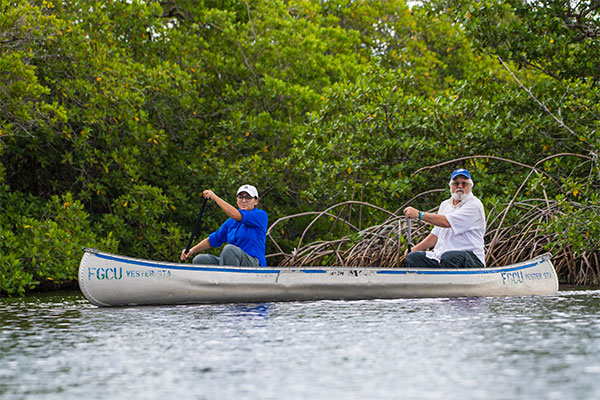Research is a primary focus of the Everglades Wetland Research Park
Many faculty, postdocs, graduate students, staff, student interns, and visiting scholars
frequenting the offices and labs of the beautiful new Kapnick Center are doing research
that is key to the survival of our ecosystems and indeed our planet.

Research Topics
-
Coastal Mangrove Wetlands
Toggle More Info
Ecosystem Services of Coastal Mangrove Wetlands
We are beginning measurements of methane emissions and carbon sequestration in mangrove
coastal wetlands. Early results show that methane emissions are essentially zero but
carbon sequestration rates are comparable to nearby freshwater wetlands. These measurements
validate the renewed interest in the concept of coastal saltwater wetlands such as
salt marshes and mangroves being carbon sinks; in fact that concept has a now accepted
term of “blue carbon.” The EWRP has also done some research on the importance of
mangrove wetlands serving as buffers for coastal storms and tsunamis in tropical regions
around the world (Marois and Mitsch, in press).
-
Methane Emissions & Nutrient Retention
Toggle More Info
Long-term Patterns of Methane Emissions and Nutrient Retention in Created Wetlands
Created wetlands may or may not contribute to climate change because they both sequester
carbon but also emit the greenhouse gas methane. Studies of methane emissions, began
by our lab in 2003 at the Olentangy River Wetland Research Park in Columbus, Ohio,
including large-scale methane emission estimates from an eddy covariance tower created
at this site. Support from the National Science Foundation allowed us to compare two
different chamber techniques that we have used for methane emission measurements (Waletzko and Mitsch, 2014). That paper is being published in a new special issue (Mitsch et al., 2014a) along with a re-evaluation of the nutrient retention trends of the experimental
wetlands at the Olentangy River site in Ohio (Mitsch et al., 2014b). We found that after about 10 years, there are signs that retention of nitrogen
and phosphorus are starting to increase from year to year, something counter to the
conventional wisdom of many previous studies of created wetlands. EWRP is also involved
in an international (organized in Sweden) meta-analysis of the literature on nutrient
retention in created and restored wetlands (Land et al., 2013).
-
Nutrient Removal Efficacy
Toggle More Info
Nutrient Removal Efficacy of Wetland Plant Communities in the Florida Everglades
This 3-year, 18-mesocosm study focused on estimating the efficacy of different wetland
plant communities for reducing phosphorus input into the Florida Everglades. This
project was part of the overall Everglades Restoration where 23,000 ha of wetlands,
called Stormwater Treatment Areas (STAs), have been created on former agricultural
land that had, in turn, replaced wetlands decades ago. The study investigated if certain
types of wetland communities are better than others in reducing phosphorus inputs
to the Florida Everglades, thus reducing the invasion of plants such as Typha (cattails)
from taking over the native Cladium (sawgrass) in the Everglades “river of grass.”
Our study (Mitsch et al. 2015) found that by the end of the study, the Nymphaea, control/Chara, and Typha vegetation
communities had lower outflow phosphorus concentration than the inflow (p < 0.05)
with average outflow concentration of 11 ± 1, 15 ± 3 and 16 ± 1 ppb respectively.
We conclude that any treatment wetland constructed with local Florida soils and designed
to achieve low (~10–15 ppb P) concentrations would probably take a minimum of 2 years
to become sinks of phosphorus. We also conclude that wetlands can be created to achieve
these low thresholds if low TP loading and self-design strategies are incorporated
into the project design (Mitsch et al., 2015). Two companion studies on this project are also published. Villa and Mitsch (2014) investigated the contribution of the different wetland plant species to exported
DOC (and by inference to DOP) by using carbon stable isotope techniques. Marois et
al. (in press) investigated the relative importance of aquatic metabolism on the retention
of phosphorus in these vegetation communities and found that plant communities without
emergent macrophytes may perform best in the retention of phosphorus in low inflow
concentration conditions.
-
Carbon Fluxes
Toggle More Info
Carbon Fluxes in Subtropical Wetland Ecosystems
Corkscrew Swamp near Naples Florida— considered by some to be one of the world’s most
majestic forested wetlands in the USA —was chosen as a convenient site for comparing
different wetland ecosystems in the Everglades: sawgrass wet prairies, bald cypress
swamps, pond cypress swamps, and pine flatwoods—for their ability to sequester carbon
into permanent soil storage as well as for their emissions of the greenhouse gas methane.
These measurements will ultimately help to estimate the net effect of wetland ecosystems
such as those found at Corkscrew in the cooling or warming of the planet. The results,
published in two recent papers, illustrate that seasonality in methane emissions was
positively correlated with water levels but not with soil temperature (Villa and Mitsch, 2014) and that carbon sequestration was not necessarily enhanced by prolonged saturated
conditions but may be affected more by the quantity and chemical composition of the
organic material reaching the soil (Villa and Mitsch, 2015). These studies are continuing by comparing methane emissions from these pristine
wetlands with more heavily impacted forested and herbaceous wetlands on FGCU’s campus.

